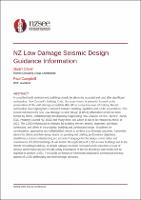NZ Low Damage Seismic Design Guidance Information
Abstract
In a resilient built environment, buildings should be able to be occupied and used after significant earthquakes. New Zealand’s Building Code, like many others, is primarily focused on the preservation of life, with damage acceptable after all but a very low level of shaking. Recent earthquakes have highlighted a mismatch between building regulation and public expectations. This session introduces the new Low Damage Seismic Design (LDSD) information which has been funded by MBIE, collaboratively developed by Engineering New Zealand, SESOC, NZSEE, NZIA, EQC, Property Council NZ, ICNZ and many more, and which is due to be released by MBIE in 2021. The LDSD information is intended for building owners, tenants, engineers, architects, contractors, and others in the property, building and construction sector. It outlines the conversations, approaches and collaboration needed to achieve Low Damage outcomes. It provides advice for clients and their design teams on agreeing and briefing performance objectives, establishes a shared understanding and consistent language for the design, construction and maintenance of LDSD buildings. It will inform the application of LDSD in new buildings and to the retrofit of existing buildings. A simple pathway has been proposed which prescribes a level of seismic performance beyond the life safety imperatives of the NZ Building Code which will be required to achieve LDSD. The LDSD performance framework proposed is summarised and key aspects of LDSD philosophy and methodology discussed.

